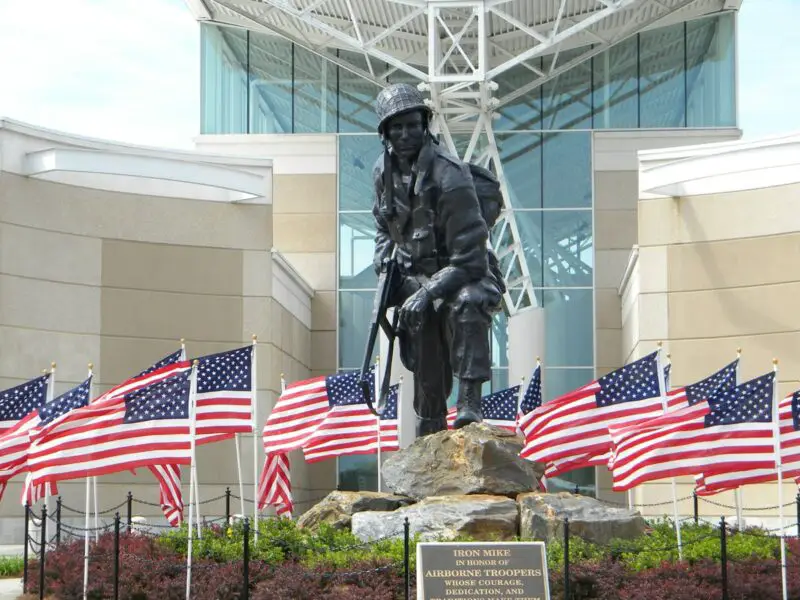Why Is Fayetteville Important?
Now home to the world's largest military base, Fayetteville was named for Marquis de Lafayette, a hero of the American Revolution. The city was the setting for a session of the North Carolina General Assembly in 1789 called to adopt the United States Constitution and launch the University of North Carolina.
Throughout Fayetteville and Cumberland County today you will find fitting tributes to the brave men and women who have kept America free.
Here are 10 sites in and around Fayetteville you definitely will want to visit.
Airborne and Special Operations Museum
Enter the Airborne and Special Operations Museum through the 5,000 square foot lobby and you will be struck by the two fully deployed parachutes, one a World War II era round chute and the other a modern square chute. As you continue on, you'll find exhibits and artifacts detailing the early days of the Airborne, World War II, Korea and the Cold War, Vietnam and contingency operations around the world.
82nd Airborne Division War Memorial Museum
Located on Fort Bragg, the 82nd Airborne Division War Memorial Museum chronicles the famed 82nd Airborne Division from its founding to the global War on Terrorism through combat-used artifacts. On the seven-acre grounds you will see nearly every aircraft used by paratroopers since World War II. You’ll also find memorials commemorating extraordinary acts of bravery by the nation’s finest.
Arsenal Park
Following the War of 1812, the United States commissioned arsenals in five cities, including Fayetteville.
When North Carolina left the Union in 1861, local militia captured the arsenal and turned it over to the Confederacy. The arsenal was used to make rifles, ammunition and gun cartridges used to fight Union troops. During General William Sherman’s sweep through North Carolina the arsenal was captured and destroyed. Visitors to Arsenal Park see ruins of the original structure with detailed explanations of the facilities as well as a steel structure of the Northwest tower known as the “ghost tower.”
Fayetteville Independent Light Infantry Armory and Museum
The Fayetteville Independent Light Infantry Company traces its proud history back to August 23, 1793, when George Washington implemented the Militia Act. The Infantry captured the Fayetteville Arsenal for the Confederacy during the Civil War. Take a trip to the F.I.L.I. Museum to see historic artifacts, weapons, uniforms and other artifacts from the Infantry’s service. While you're there, be sure to check out the carriage ridden by Lafayette during a Fayetteville visit.
F.I.L.I. Parade Grounds
Since 1793, the land at the intersection of North Cool Spring Street and Meeting Street has been used as parade grounds for the Fayetteville Independent Light Infantry. Here on the same site where the F.I.L.I. Company was formed, ceremonies are still held today.
Fifer’s Grave
Isaac Hammond was a free African American veteran of the Revolutionary War who served as a musician for the F.I.L.I. He worked for 30 years, and his final request was that he be buried on the F.I.L.I. parade grounds in his uniform holding his fife so he would remain part of the unit. The monument marking his grave was dedicated in 1993, marking the two hundredth anniversary of the Fayetteville Independent Light Infantry Company.
Fort Bragg Experiences
If you’ve ever wondered what life is like for the heroic men and women who live and work on Fort Bragg, a unique program allows you to enlist for a full or half-day TDY (Temporary Duty Assignment). These tours are available Tuesday through Thursday, and are subject to change depending on daily operations.
John F. Kennedy Special Warfare Museum
Special Operations and Special Forces military operations have been around for more than 250 years. The John F. Kennedy Special Warfare Museum salutes the United States Army’s Special Forces, Civil Affairs and Military Information Support Operations (MISO). Throughout history the vital group has been known by various titles, including the Green Berets. Artifacts on display date back to World War I and include the OSS from World War II as well as conflicts in Korea, the Gulf and Iraq. The Museum recently moved into a new location on Fort Bragg.
Market House
The Market House was built in 1832 on the site of the State House, which was destroyed by fire. The National Historical Landmark once hosted stalls selling meat, produce and other goods underneath while City Fathers conducted business upstairs. Occasionally slaves were sold to pay off indebtedness or in estate sales.
North Carolina Veteran’s Park
The North Carolina Veteran’s Park, which opened in 2011, is next to the Airborne & Special Operations Museum. Enter through the 3,500 square-foot Visitor’s Center where you will see an impressive Service Ribbon Wall containing every type of military service medal awarded since the Civil War. Outside traces a Veteran’s Journey before, during and after service with interactive exhibits.




